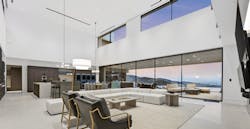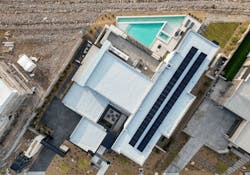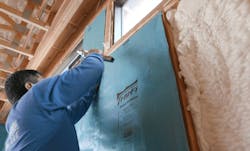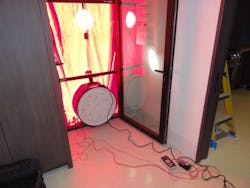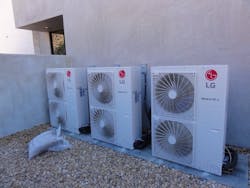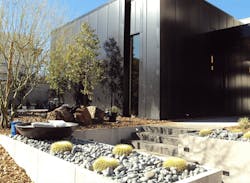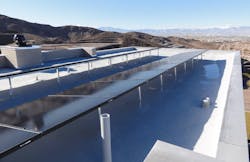Lessons in Energy Efficiency and Sustainability From The New American Home
Each year the International Builders’ Show features a show home built to demonstrate the latest in home design, building technologies, and innovation. The New American Home (TNAH) 2023 not only showcases stunning design and views of the Las Vegas Valley but also serves as a model of high performance in home design, from the home's natural resource efficiencies and renewable energy systems to the healthy, comfortable indoor environment it creates for its owners. But what happens in Vegas doesn't have to say in Vegas: Home builders can apply many of the materials, methods, and home-performance best practices that make TNAH 2023 exemplary to build their own energy-efficient homes.
TNAH 2023 Performance Achievements
- HERS Index: -15 (50 without solar)
- Water savings: 50% below baseline
- Airtightness: 2.98 ACH (50)
- National Green Building Standard (Emerald)
- DOE Energy Star for Homes and EPA Indoor airPLUS certification
Essential Elements for Building a High-Performance, Energy-Efficient Home
As the green building and energy consultants on the home (and on several previous TNAH projects), the team from Two Trails collaborated with Luxus Design Build and its trade and materials supply partners to meet the highest standards of energy and water savings, indoor air quality, and reliable comfort to deliver an ultra-efficient home.
But although this Las Vegas home is a luxury dwelling, the products, systems, and best practices used in TNAH 2023 can actually be applied to any residential property at any price point for greater energy efficiency and better home performance.
Here are the keys to the home's success.
Optimizing for Energy Efficiency: Passive Solar Design
Working with the path of the sun to determine a home’s orientation is one of the most overlooked aspects of site selection for many homes. Yet designing a home that will function properly and more efficiently depends a great deal on how the structure is sited on the lot.
The orientation of The New American Home 2023 is optimized for both solar gain and shading. The home is designed to take advantage of the sun’s natural light and heat, with large windows and skylights strategically placed to allow maximum daylight, which reduces the need for artificial lighting. At the same time, south-facing glass is shaded to prevent overheating and increased cooling loads in the spring and fall.
RELATED
- The New American Home 2023: A Haven on the Hill
- High-Performance Features in The New American Home 2023 [Webinar]
- Stylish, Innovative, Efficient Products Featured in The New American Home 2023
Keeping It Tight: Thermal Envelope
In a high-performance home, the thermal envelope is essential to achieving home energy savings and healthy indoor air quality, and it starts from the ground.
Thermal bridging can be a major source of energy loss in buildings. Thermal bridges are essentially areas in the building envelope that allow heat to pass through more easily and occur where materials that are better conductors of heat form a "bridge" between the inner and outer face of the construction. So for a high-performance thermal envelope, it's essential to seal around penetrations, such as electrical outlets behind the faceplates, doors and windows and around sliding glass door openings, and in storage closets not located in conditioned space.
Thermal bridging and air and moisture infiltration through the thermal envelope can reduce insulation's effectiveness and lead to uncomfortable cold spots inside the home, so it's critical to properly and completely seal penetrations into the building shell prior to drywall being installed. (Once a building reaches the drywall stage, sealing penetrations is a case of out of sight, out of mind.)
In addition to a tight structural frame, TNAH 2023 combines a 2-inch layer of open-cell spray foam insulation in 2x6 wall cavities with a multi-layer reflective barrier from Fi-Foil. (The ceiling also uses a thin but durable multi-layer reflective barrier from the manufacturer.) This hybrid approach, which optimizes the thermal benefits of both products in tandem, provides superior thermal resistance compared with using traditional batt or blown-in fiberglass insulation. That said, the choice of insulation must be appropriate for the climate and the building type and, of course, it must be installed properly.
In addition, a 2-inch-thick continuous layer of rigid foam insulation was applied to the outside surface of the home's perimeter walls to further reduce thermal bridging, enabling the whole wall assembly to achieve R-30 or greater, well above code minimum.
The 2023 New American Home also used a product called Aeroseal to fill even the smallest cracks in the thermal envelope prior to drywall being installed. In a depressurized environment, the spray-applied product seeks out small fissures and seals them against air leaks. It's like “fix-a-flat” for home building.
RELATED: Energy-Efficiency Road Map: Whole-Building Envelope Sealing
Proper Design and Installation of the HVAC System
Correctly installing the heating, ventilation, and air conditioning system ensures the comfort of the home’s occupants while reducing energy consumption and providing optimal indoor air quality.
Properly sizing the HVAC equipment is critical; a unit that’s too small will struggle to keep up with the demands of the occupants and will lead to energy waste and compromised comfort. An oversized unit will consume more energy than needed and may result in the unit not being able to maintain consistent temperature and humidity levels while constantly cycling on and off.
TNAH 2023 specified LG’s Multi-V, variable refrigerant flow (VRF) system with a SEER 18.9 efficiency rating. This multi-zoned system consisted of smaller outdoor condenser units (see below) and in-wall/in-ceiling interior units that are completely contained in conditioned space to reduce thermal loss, improve the home's energy efficiency, and deliver consistent, reliable indoor comfort.
Ductwork design is also an important aspect of an energy-efficient home, considering such factors as the HVAC system's airflow rate, pressure, and temperature differentials to help maintain indoor comfort and reliable temperatures and energy use. Of course, the ducts need to be properly insulated, sealed, and balanced to reduce thermal loss and air leaks that erode energy savings. Performing a blower door test (see above) provides immediate feedback about any duct leaks, in addition to the home's overall air leakage.
Indoor Environmental Quality for Better Occupant Health and Comfort
The quality of the indoor environment affects occupant health, comfort, and productivity. Proper ventilation is crucial for maintaining good indoor air quality (IAQ). It helps remove pollutants while cycling fresh air from the outside, preventing a build-up of indoor pollutants such as carbon dioxide, volatile organic compounds (VOCs), and allergens.
With that, removing pollutants from the air such as dust, pollen, pet dander, and other allergens—what indoor air quality geeks call “source control”—creates a healthy baseline of indoor air from the get-go.
In addition, ignoring high humidity levels can lead to growth of mold and mildew and can encourage bed bugs. Humidity that’s too low can cause dry skin and respiratory irritation for occupants.
TNAH 2023 has a fully automated whole-home fresh air system that uses sensor technology to continuously monitor and exhaust air pollution caused by increased humidity, VOCs, smoke, carbon dioxide, and small particles. The system from Broan-NuTone automatically activates the nearest ventilation fan or range hood to remove contaminated air while bringing in fresh outside air and features three modules that can be monitored and controlled in real time using a mobile app.
Finally, proper lighting can improve occupant comfort and productivity as well. The New American Home 2023 features 100% LED lighting, both indoors and out, which helps to reduce energy use and costs, as well as bulb replacement costs and hassle ... especially for fixtures located in volume spaces such as the open floor plan in the center of The New American Home.
With that, choosing the right color temperature is key to achieving a pleasing ambience; color temperatures range from 2,700K to 3,000K for warm light and 5,000K to 6,500K for cool white.
About Color Temperature
Color temperature is a way to describe the appearance of the light provided by a light bulb. Measured in degrees of Kelvin (K) on a scale from 1,000 to 10,000, color temperatures above 5,000K are described as cool colors (bluish), while lower color temperatures (2,700K–3,000K) are described as warm (yellowish). As a general rule, the higher the Kelvin rating, the whiter the light will be.
An equally important aspect of choosing fixtures and lights is looking for high-quality LED chips to ensure maximum efficiency and longevity. Energy Star–certified products meet strict efficiency and quality standards, and LED lighting is now often dimmable. Occupancy sensors can be installed to further reduce energy consumption for a more energy-efficient home.
Water Efficiency
Take it from an expert: High-efficiency toilets, showerheads, and faucets, as well as Energy Star–rated water-using appliances, really do reduce water consumption without sacrificing performance.
Outdoors, you can achieve significant water efficiencies by using plants that are native to the climate zone, along with a landscape design that considers what each plant will need in terms of water, fertilization, and sunlight. Installing drip irrigation will greatly reduce the need for constant watering, since the water is delivered directly to plants' roots, while traditional sprinkler systems are more difficult to control and the water evaporates more quickly.
The New American Home 2023 is outfitted with a wealth of water-saving products, including kitchen and laundry appliances from Signature Kitchen Suite and LG, respectively, and highly efficient plumbing fixtures and faucets from Kohler. Outside, an automated drip irrigation system for the home's drought-tolerant landscaping keeps water where it needs to be (at the base of each plant), significantly reducing wasteful evaporation.
Combined, these features reduce the home's water use by 50% compared to a baseline home of comparable size—a critical consideration in a hot, dry desert climate, such as Las Vegas.
Energy Efficiency
Look for the Energy Star label (usually bright yellow with black writing) on all appliances. The label indicates the appliance meets or exceeds energy-efficiency standards set by the Environmental Protection Agency (EPA).
That said, not all Energy Star-rated appliances are equal. Some models are more efficient than others, even among those made by the same brand. Those featured in this home from Signature Kitchen Suite are all certified energy efficient—from the 48-inch range/oven to the French-door refrigerator to the beverage chillers and warming drawers.
A tankless water heater, sometimes referred to as an on-demand water heater, offers energy efficiency and a continuous supply of hot water, but you have to ensure the unit is the right size for the home's needs, since incorrect sizing can lead to inadequate hot water supply.
The Rinnai units installed in TNAH 2023 use recirculating technology to provide almost instant hot water and a consistent flow, which significantly reduces wasteful "lag time" waiting for hot water to reach the tap or showerhead.
Yes, the New American Home 2023 has a dramatic (and clever) zero-edge pool, and there is no argument that pool pumps can be an energy suck. The one in this home, however, meets Energy Star standards to use less energy compared with standard models. These pumps also go through further testing for durability and performance while often providing enhanced functionality.
The pool pump is just one piece of your pool filtration system. For the entire system to run efficiently, it’s important not only to get the sizing right but to also ensure the system has proper plumbing and electrical connections, and that it’s compatible with other pool equipment.
On-Site Renewable Energy (Solar)
Solar panels are a great way for homeowners to reduce their carbon footprint and save money on electricity bills. Key factors when considering installing solar panels include:
- Location: The location of solar panels is critical for optimum performance. Ideally, panels should be south facing in the Northern Hemisphere and north facing in the Southern Hemisphere.
- Roof structure: Weight is a factor, and the roof structure needs to be engineered and built to handle the additional load of the solar panels.
- Shading: Any shading on solar panels can greatly reduce their efficiency. This also includes shadows cast by nearby buildings and trees.
- Inverter: This is the most critical component of the solar energy system. The inverter converts DC (direct current) power generated by the solar panels to AC (alternating current) power to be used within the home.
- Maintenance: Accumulation of dirt and debris on the surface of solar panels over time will affect the panels’ performance. It’s important to clean panels at least once a year.
For TNAH 2023, the project team benefitted from a flat roof that enabled the installation of an extensive 20kW solar array of Solaria PowerXT 400-watt solar panels. The system uses micro-inverters from Enphase to provide more precise troubleshooting of each panel's performance, as opposed to inverters that connect to multiple (or all) of the panels.
All of the factors mentioned above are proven building science, performing together and interacting with the natural environment to create a comfortable, efficient living environment. The New American Home showcases the latest in building technologies and sustainable methods so home builders can see these products and innovations at work.
Drew Smith is the chief operating officer of Two Trails, a company focused on sustainable building consulting. A sustainable building expert for more than 15 years, he formed the company to help builders, developers, and homeowners understand the process of green building and to provide them with the knowledge to easily bring their green projects to life. For more information, go to twotrails.com.
